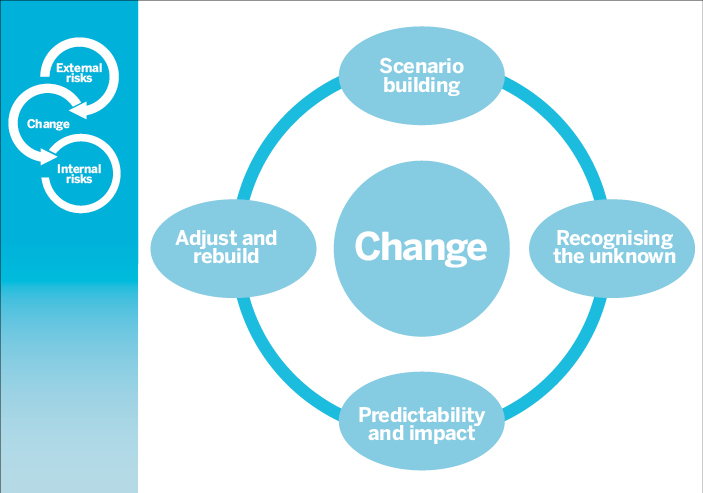Maintaining operational resilience is key to surviving a crisis
As the impact of the Covid-19 pandemic places additional pressures on even the most resilient businesses, Deutsche Bank’s Linda McLaughlin-Moore and Bill Mott share insights into the preparedness of international banks and how they can best adjust to the new operational environment.
The response to the Covid-19 pandemic has had a profound effect on businesses across the globe – putting the most resilient of business continuity plans through their paces. For the complex, closely regulated structures of financial institutions, external shocks the size of the current pandemic can impede and dislocate entire value chains.
As with previous shocks, such as the 9/11 attacks of 2001, the movement of money is heavily impacted by changeable organisational needs – with many businesses moving funds from illiquid assets, such as stocks and bonds, to liquid assets, such as cash, at their banks.
It is for these reasons that organisations constantly evaluate business continuity management (BCM) scenarios to influence their operations strategy, should external factors come into play. But what are the key steps that banks have taken, and are currently taking, to continue serving their clients? And what is the outlook for a post-Covid world?
Scenario modelling
The first element of a robust response is preparation. More often than not, especially for large financial institutions, there is an element of being proactive, as well as reactive, here. First, as Linda McLaughlin-Moore, Deutsche Bank’s global corporate bank and branches operations executive, explains: “You have to step back and take a look at your end-to-end ecosystem, your influencers, dependencies, and disruptors, as well as what actions you can take that allow you to move forward in a positive way.”
For a large international bank, such as Deutsche Bank, this included building out scenarios when the pandemic first began and modelling the potential impact of the virus more broadly than in China and Asia. While no one expected the virus to displace so much of the work force, banks have had to think through the what, where, when and who of how disruptions can occur, and practise their impact in multiple combinations in the scenario planning. Whether the impetus comes from a client, a government, a supplier or another agent, it is important to understand how each of these could affect operations.
Ms McLaughlin-Moore concludes that, if predictability has been properly built into the scenario planning, then banks should have a “plan B” ready, though she adds that it is important to “fail fast, adjust and test again”.
An efficient engine room
In response to the Covid-19 pandemic, governments and central banks were quick to introduce several critical monetary and fiscal support measures to help stabilise economies. In isolation, however, these measures would not have been enough. It has fallen to the commercial banking industry to facilitate the state support and to help maintain liquidity in the corporate sector.
For example, Deutsche Bank has been able to support more than 5200 clients applying for loans from German development bank KfW worth around €4bn, and has earmarked a further €20bn for overall new credit extensions to corporate clients.
This response is being achieved through guaranteeing that the funds reach their intended destinations regardless of value, volume and timescale; ensuring credit is available with the relevant risk checks; and continuing to provide post-trade services – with all the checks and balances in place – during a time of record volumes, high levels of volatility and increased client demand.
Crucially, as described in a recent report by US consultancy Oliver Wyman, banks must continue to provide their customers with the necessary financial products and services at this critical moment – a time when strong bank-client relationships are more important than ever. As the report says: “Banks must react to rapid changes in channel usage in the short term and anticipate changes in customer demand that these shifts will drive in the medium term.” Put simply, it is not just about bolstering stability; it is also about going the extra mile for clients.
As such, in the midst of the crisis, with banks no longer able to absorb negative interest rates and trade finance seeing severe price compression, the medium-term competitive landscape is being redrawn – with those meeting the crisis head on likely to come out on top. The new order will come down to one question: how efficient is your engine room?
Maintaining business as usual
In order to minimise the Covid-19 pandemic’s effect on day-to-day operations, most banks have triggered their business continuity plans (BCPs). For example, both during the crisis and long before, Deutsche Bank has been continually testing and optimising its BCPs, which includes plans for split work sites, working from home arrangements and amended travel policies, as well as an array of health and safety measures.
But even with the best laid plans of banks and clients, how exactly are business lines continuing to operate with little to no reduction in workload? Bill Mott, Deutsche Bank’s chief operating officer, corporate bank and branch operations, says that as global lockdowns began to drive market volatility, the corporate bank saw significant spikes in transaction volumes – some by as much as 300% in a single day – across multiple products.
He says: “These challenges were managed via increased time worked by employees, by shifting employees from non-line roles into essential support, by cross-product sharing of resources, as well as support from the business as they helped manage client expectations.”
In addition, as physical offices close, virtual channels have become more important than ever. Technology is meeting the needs of the new work environment and, as Mr Mott explains, the crisis has pushed the industry “to move two to five years faster than it would have done if this had not happened”. What was considered normal six months ago, will no longer be the norm in six months’ time.
Against this backdrop, operations and technology have never been more important in managing the day-to-day. As the technology used to execute tasks evolves – be it through data analytics, application programming interface connectivity or distributed ledger technology, among others – so too will the underlying operating and business models.
Client demand
Going the extra mile for clients means remaining flexible enough to meet their current demands, whatever they might be. At Deutsche Bank, this led to some cash management clients asking for “out of the ordinary” types of payments, such as dividend payments, at very short notice.
One example of an “out of the ordinary” request was when a client’s new legal entity in India needed a capital injection from its parent company in Singapore while both economies were completely locked down. The request had a demanding regulatory timeline and required a complex foreign exchange conversion to be performed seamlessly. To complicate matters further, the parent company had restrictions that prevented the capital injection going through in one lump sum – something stipulated by the Indian regulators. Deutsche Bank developed a solution in which the parent company’s authorisation measures were updated, so they could meet the tight deadline despite the restrictions imposed by the lockdown.
The bank’s IT team has also been able to react rapidly to client demands by setting up flexible processes around digital signatures that enable corporate bank customers to continue operations from home. The team also ensured that Skype streams remain able to cope with the tenfold increase in phone minutes going through the system.
Achieving excellence
The extraordinary circumstances brought about by the Covid-19 pandemic have stretched the operational stability of banks to new limits. As hundreds of millions of employees around the world packed up their offices and moved to work from home, robust BCM has been necessary to maintain day-to-day operations. But maintaining stability has proved to be just one part of the puzzle.
As it becomes clear that lockdown measures, whether still in place or having been just lifted, will impact work flows for the foreseeable future – perhaps even creating a new normal – the banks that have continued to support their clients through these trying times will likely see the greatest benefits.
Key takeaways
- Strategic resilience is being able to anticipate and adjust to any sudden and deep trend;
- Commercial banks maintain corporate sector liquidity and facilitate government support; this is taxpayers’ money and needs all the usual checks and balances;
- Enhanced digital technologies and workflows enable more employees to work from home;
- The whole operational ecosystem should be under constant review;
- Check influencers, dependencies and disruptors;
- When running scenarios, fail fast, adjust and test again – do not take too long to ponder each outcome;
- Be prepared for significant spikes in transactional volumes, increased demand for sudden turnaround and more granularity in reporting and updating;
- Front, medium and back office are misnomers in a crisis, as everyone pulls together;
- Each crisis improves readiness for the next crisis.
This article is an extract from the flow article, From the engine room, first published on May 6, 2020.




